Why does dill turn yellow in the garden and what to do to prevent it
Dill is a healthy greenery, without which no kitchen in the world can do. It seems that it is not difficult to grow it. However, experienced gardeners do not think so. This plant is capricious, requires attention and proper care. First it grows and develops, then turns yellow, the leaves curl, aphids appear.
Why does dill turn yellow in the beds and what to do in such situations? We will answer these and other questions, we will reveal all the secrets of growing, we will introduce you to planting schemes. You will learn how to feed plants using only organic fertilizers. Advice from experienced gardeners will help you grow crops without losses.
The content of the article
Causes of yellowing of dill and how to eliminate them
Don't know why dill turns yellow in the garden and what to do? There are many reasons for this. Experienced gardeners noticed that this the plant grows well next to potatoes, sowing on its own... However, when it is planted in separate beds, it often gets sick and disappears. This is due to violation of agricultural practices: improper planting, lack of fertilizers, non-observance of crop rotation and many other factors.
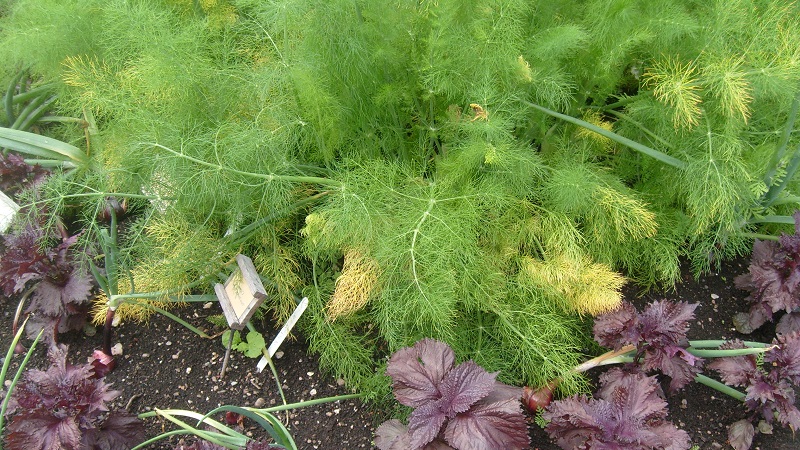
Dry or excessive soil moisture
Dill does not tolerate dryness, but excessive moisture is also harmful for it.... In extreme heat, the leaves curl - this is the first sign that the dill lacks moisture. From the heat, the plant weakens and becomes sick. In such cases, abundant watering is required.
Rainy weather and over-watering can cause root rot. Watering dill is necessary in the evening at the root. The soil should be moist and loose.
Pests
The main pest of dill is aphids... Noticing that the dill is curling, you need to check it for the presence of aphids. These insects live on the upper shoots. They do great harm to the plantation by feeding on the sap of the plants.
Get rid of the ants first when fighting aphids.... These insects feed on the sap secreted by aphids and carry them from plant to plant.
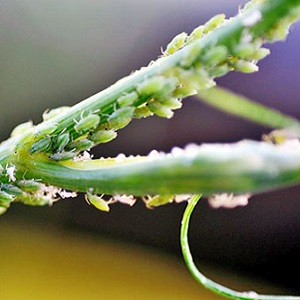 There are folk methods for pest control:
There are folk methods for pest control:
- Dissolve 1 tbsp. l. baking soda in 1 liter of water, add 2 g of laundry soap. Treat leaves and stems from all sides.
- Spray the bushes with Coca-Cola.
- Insist nettle leaves in water for 5 days and process the bushes 2 times a week.
Attention! Chemicals cannot be used, since the ground part of the plant is used for food.
The fight against ants must be carried out throughout the season.... To destroy anthills in the fall, they dig up the ground. If the insects have not gone away, the following measures are applied:
- Dry powder of mustard or cinnamon is sprinkled on the anthill.
- The ant passages are poured with soapy water.
- The rags soaked in kerosene are laid out in the anthill.
Read also:
Review of the best varieties of dill for greens and umbrellas
How to quickly germinate dill seeds and accelerate germination
Sun exposure
Dill is a light-loving plant... However, in hot weather, direct sunlight has a negative effect on it. The leaves turn yellow, curl, begin to dry and disappear. To avoid the problem and get juicy greens on hot days, the beds are darkened with agrofibre or old tulle.
Planting density
In pursuit of the harvest, remember that dense planting will not be beneficial.... Seeds are sown in rows at a distance of 1-2 cm from each other. If the planting is thicker, young shoots will stretch out, become thin and weak. The lower leaves will begin to turn yellow, red, and dry out. As it grows, dill is constantly thinned out, leaving a distance of 20 cm between the bushes for seeds to ripen.
Council. Dill seeds have poor germination, so they are soaked before sowing.
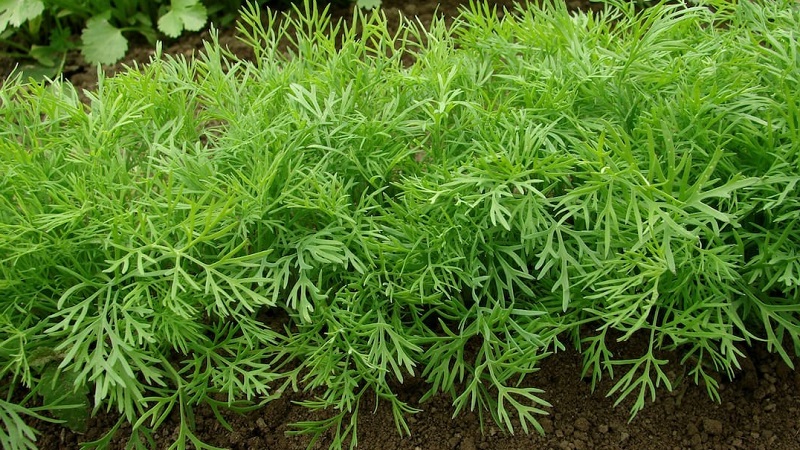
Soil acidity
The acidity of the soil is of great importance... Dill turns yellow in a garden bed with acidic or alkaline soil. The plant cannot assimilate phosphorus, begins to starve and becomes ill. He needs neutral soil.
Important! It is impossible to bring ash for feeding into acidic soils - this can harm the crop.
Can be fed with humus, compost or any organic fertilizer.
The acidity level is determined by what grows in the garden... For example, the presence of a biting midge indicates that the soil is acidic.
To deacidify the soil, they bring:
- slaked lime;
- a piece of chalk;
- dolomite flour.
It can be useful:
Lack of fertilizer
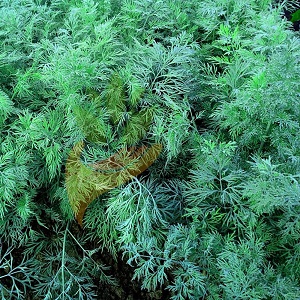 Can dill disappear from malnutrition? The answer is unequivocal - yes. If the plants have thin stems and a pale yellowish appearance, then they lack nitrogen.
Can dill disappear from malnutrition? The answer is unequivocal - yes. If the plants have thin stems and a pale yellowish appearance, then they lack nitrogen.
How to feed dill so that it does not turn yellow:
- Rotted manure or grass compost laid out under bushes and between rows. They bring in 1/3 of the bucket per 1 meter of the garden.
- Also use superphosphate... It is dissolved in water in a proportion of 2 tbsp. spoons in a bucket of water. Watering in the evening after watering, 0.5 liters under a bush.
Attention! Fresh manure must not be applied.
From a lack of nutrition, the immune system of dill weakens, the plant begins to ache. Major diseases:
- Root rot... It appears as a wet spot at the base of the plant. Such bushes should be removed immediately, since the disease cannot be treated. To prevent root rot, you need to regularly loosen the ground and avoid dense planting.
- Verticillary wilting... This disease is caused by a fungus that affects the vessels of the plant. Not receiving adequate nutrition and moisture, the dill leaves curl, turn yellow and fall off. Fertilizing with potash and phosphorus fertilizers will help against verticillary wilting.
Is it possible to eat such dill
You can't eat dill affected by aphids or diseases... If the leaves turn red or yellow from lack of nutrients or weather conditions, the plant is edible. It can also be used for conservation.
Preventive measures and rules for growing healthy dill
Do not wait for the dill to turn yellow and disappear. Start taking preventive measures right away.

The main rule is to follow agricultural techniques... Each gardener has his own growing secrets. Let's consider the most important ones:
- Soil preparation... It is better to start with the autumn digging, check the acidity, add rotted manure or humus. Add lime or dolomite flour to acidic soil to regulate the PH balance.
- Variety selection... To harvest at the end of May, use early varieties: Gribovsky, Umbrella. A later harvest is given by the varieties Kibray, Lesnogorodsky, Salyut.
- Seed hardening... Before planting, the seeds are heated on a battery or poured with hot water for 30 minutes. Then it is cooled by placing in a refrigerator and dried. For disinfection, a potassium permanganate crystal is added to the water.
- Landing dates... Dill is sown in late autumn or early spring as soon as the snow melts. They are planted with dry seeds to a depth of 1-2 cm in holes 10-15 cm wide. If planting is carried out at the end of April, the holes are pre-watered and covered with humus. Dill can be sown again every two weeks until the end of August. Planting sites are chosen light, it is good to use the neighborhood with potatoes or beets.
- Observe crop rotation... It is impossible to sow dill in one place annually, as it is susceptible to fungal diseases.It is not recommended to plant after parsley, carrots, celery.
- Crop care includes watering, weeding and feeding... Water it 1-2 times a week. Weeds are removed, the earth is constantly loosened. It is important to remember that dense plantings negatively affect the harvest: the plants stretch, become thin and stop developing. The distance between the bushes should be 15–20 cm. Top dressing is carried out every two weeks with organic fertilizers and superphosphate.
- Pest control... Before planting, the land is examined for the presence of ants and measures are taken to destroy them using folk remedies. Nettle helps to get rid of aphids. This preventive agent not only repels insects, but also nourishes and strengthens the plant.
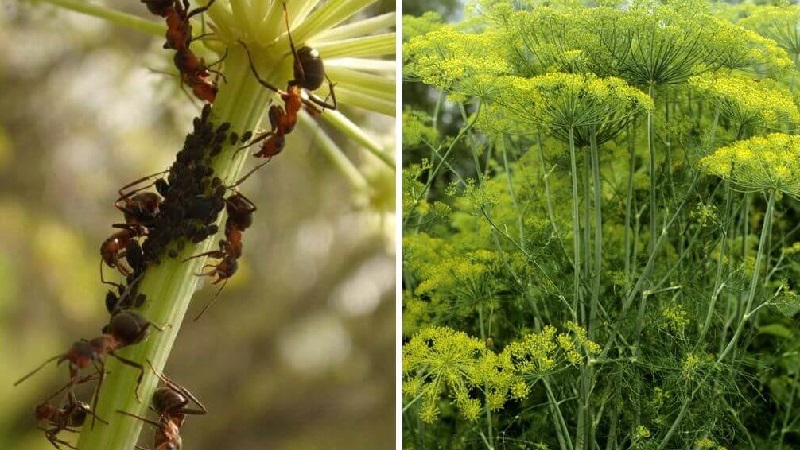
Other problems with dill in the garden and ways to solve them
You can often see twisted, dry or red dill leaves in the garden.... Inexperienced gardeners do not pay attention to this until the plantation begins to disappear. Let's figure out why dill turns red, curls and dries up.
Blushes
The reason why this happens is night frosts.... Although dill is a cold-resistant plant, its leaves turn red at low temperatures. Early sowing is considered the only control method. If you decide to grow fresh herbs in September, cover the beds with foil.
Curls up
Why does dill curl? The ants are to blame... These insects feed on the milk of aphids, which are "grazed" on young shoots of dill. Aphids serve as a kind of "cow" for them. The fight against aphids and ants must be started at the same time.
Important! Use folk methods in the fight against aphids: baking soda, tincture of wormwood or bitter pepper, dusting with ash, mustard powder.
Dries up
Another problem that gardeners encounter is that dill dries. Why is this happening? There may be several reasons:
- improper watering;
- exposure to direct sunlight;
- dryness of the soil.
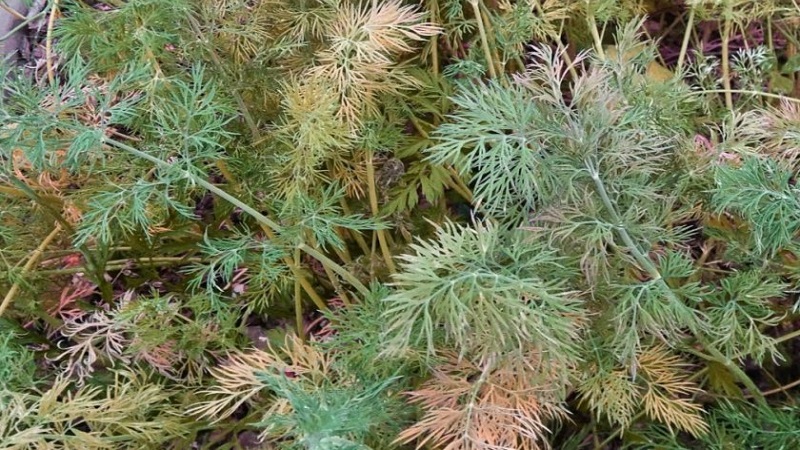
Tips from experienced summer residents
Dill turns yellow in the garden, and you don't know what to do? Popular experience will help to cope with this.
Maria, Moscow region: “Check the soil for acidity. Dill grows poorly on acidic soil, it needs neutral. Soil acidification occurs due to stagnant water, excessive application of mineral fertilizers (ammonia, potash), mulching with needles ".
Anatoly, Ryazan: “If dill curls, check for pests. The main one is aphid. In the fight against it, I use a decoction of orange peels with the addition of red pepper. I water the leaves from all sides. Aphids quickly die ".
Ivan, Tyumen: “I noticed that dill is yellow, dries up and grows poorly with an excess of organic fertilizers. You need to feed in moderation. He also doesn't like clay soil, waterlogging and cold weather. "
conclusions
Why does dill turn yellow, red, dry and curl? This is primarily due to a violation of the cultivation technology. Acidic soils, heat, excessive or insufficient watering negatively affect plants, provoking the development of diseases. Compliance with the rules of agricultural technology will help you get a bountiful harvest and not harm your health.